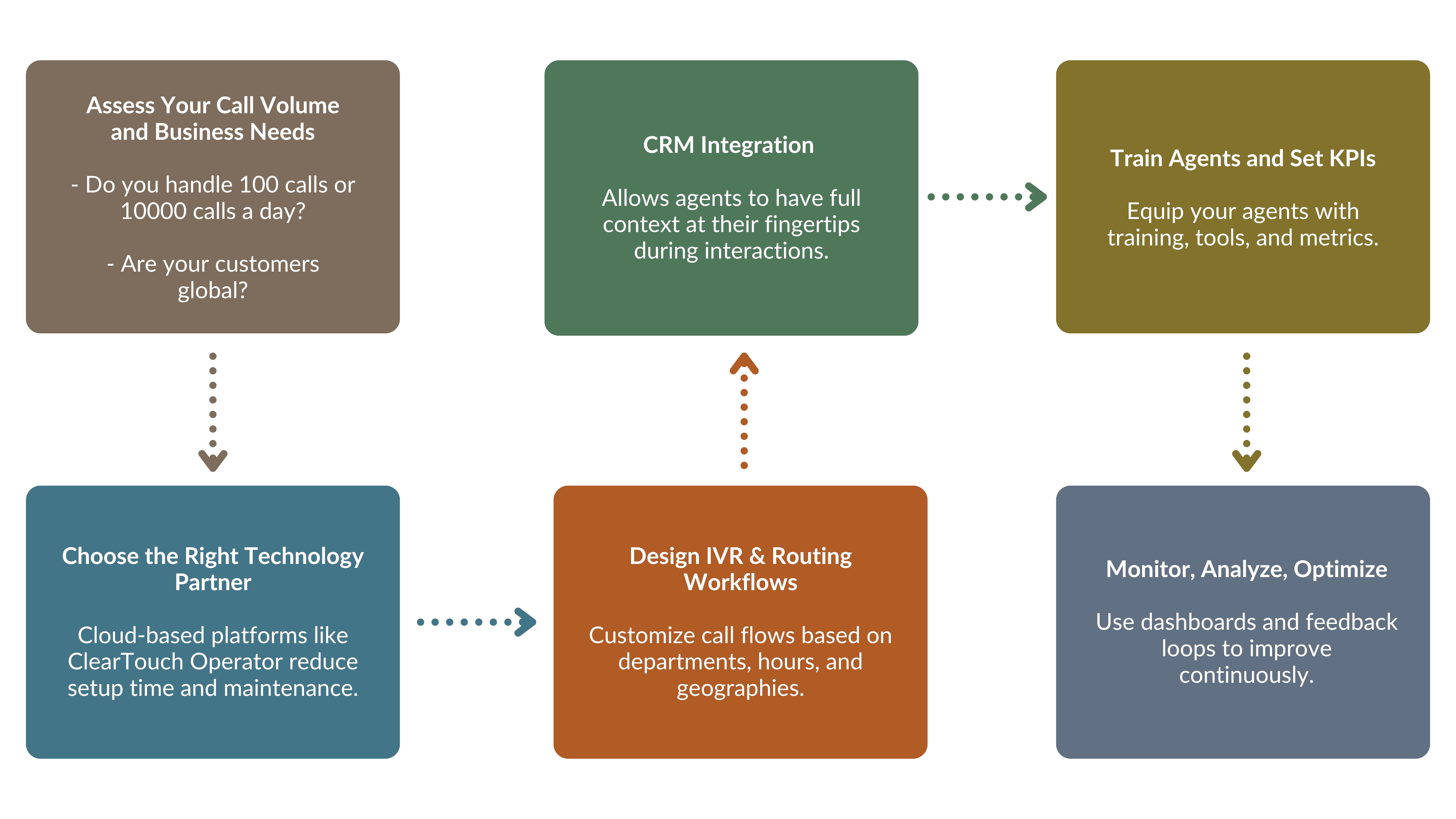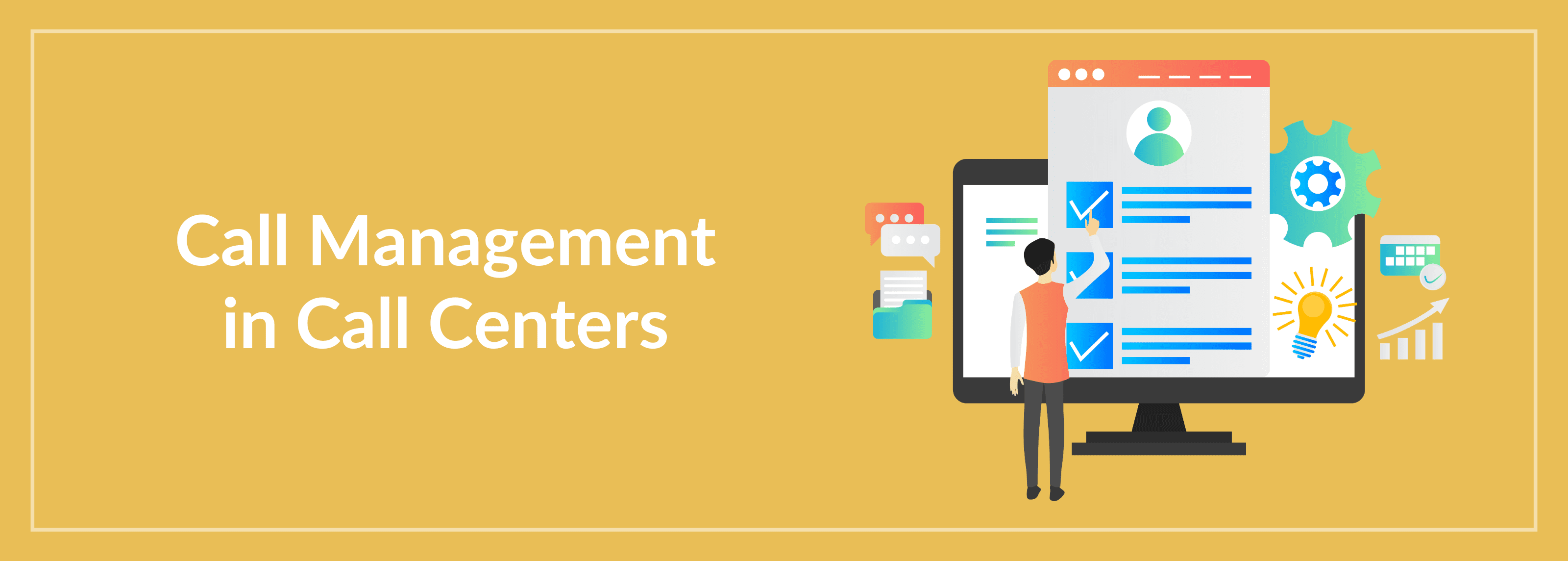Call Management in Call Centers: What It Is, Why It Matters, and How ClearTouch Makes It Easy
Call management refers to the process of handling inbound and outbound calls in the call center. It is more applicable for inbound calls than for outbound calls.
Call management includes call routing, queuing, monitoring, recording, reporting, and more.
The idea of call management is to make customer’s lives easy by ensuring that every call reaches the right person with minimal delays.
Features of Call Management
Efficient Call Routing
Challenge
Calls often go unanswered due to ineffective call routing systems.
Solution
Implement an intelligent call routing system that directs incoming calls to the right department or individual based on predetermined criteria. This ensures that calls reach the appropriate party promptly.
Skill-based routing: Route calls to agents with the specific skills needed to address the caller’s issue, improving the likelihood of first-call resolution and enhancing customer satisfaction.
Dynamic segmentation: Adjust segmentation rules based on real-time data and changing business needs, ensuring callers are always directed to the best available resource.
ClearTouch Operator has an intelligent routing solution that can do skill-based, location-based, and time-based routing.
Interactive Voice Response (IVR) Systems
Challenge
Call centers may struggle to manage a high volume of calls manually.
Solution
Deploy an IVR system that allows callers to interact with a menu and be directed to the right department or information. This reduces the workload on human operators and ensures more efficient call handling.
Tailored menus: Implement an Interactive Voice Response (IVR) system that offers a menu of options to guide callers based on their needs. This ensures that calls are directed to the most appropriate queue or agent.
Prioritization: Segment callers into different queues based on criteria such as customer status (e.g., VIPs), issue type (e.g., technical support, billing), or language preferences. This allows for more personalized and efficient handling of each call.
ClearTouch Operator has an easily configurable and customizable IVR system that can be tweaked per your needs. It can be configured based on pre-defined criteria like customer mobile number, customer IDs, and their categorization.
Call Queuing
Challenge
Long wait times can result in dropped calls or customer frustration.
Solution
Implement effective call queuing systems that inform callers about their position in the queue and provide estimated wait times. This transparency can reduce hang-ups and improve the overall caller experience.
Efficient resource allocation: Ensure that queues are neither too long, which can lead to high abandonment rates, nor too short, which might indicate underutilized agents. Aim for an optimal balance that maintains efficiency and service quality.
Dynamic adjustments: Use real-time monitoring tools to adjust queue lengths dynamically based on current call volumes and agent availability, ensuring that wait times remain manageable.
Proactive communication: If wait times are expected to be long, proactively offer alternatives such as callbacks or self-service options to reduce the likelihood of call abandonment.
Position in queue: Regularly update callers on their position in the queue and the estimated wait time. This transparency helps manage expectations and reduces caller frustration.
Hold messages: Use the hold time to play informative or engaging messages. These could include information about new products, services, or self-service options that might resolve their issue without waiting for an agent.
Real-time analytics: Use real-time analytics to monitor queue performance continuously. Track key metrics such as average wait time, call abandonment rates, and agent availability to identify areas for improvement.
Performance dashboards: Implement dashboards that provide a clear, real-time view of queue metrics, enabling managers to make quick, informed decisions.
Proactive adjustments: Regularly adjust queue configurations based on performance data and feedback. This might involve changing the number of agents assigned to a queue, updating IVR options, or reconfiguring routing rules to better match current call patterns.
Scenario planning: Prepare for various scenarios, such as unexpected spikes in call volume or agent absences, by having contingency plans to maintain service levels.
ClearTouch Operator prides itself on its call queue management functionality. It can inform customers about their position in the queue and the likely time it would take for them to be heard. Besides, it can also prioritize callers based on various parameters like purchased products, average revenue realization, subscription to premium services, etc.
Lack of Call Monitoring and Quality Assurance
Challenge
Calls may go unanswered or be mishandled without proper monitoring.
Solution
Implement call monitoring and quality assurance processes. Regularly review recorded calls to ensure that agents follow protocols and provide excellent customer service. This practice helps identify areas for improvement and maintains a high standard of call handling.
ClearTouch Operator’s voice analytics uses audio from recorded calls for searching and analyzing. It also uses other associated data, such as customer profile information or when the customer interaction occurred.
Analytics and Reporting
Challenge
Identifying call patterns and bottlenecks can be challenging without data insights.
Solution
Implement analytics tools to gather data on call volumes, peak times, and areas where calls are frequently abandoned. Analyzing this data helps optimize staffing levels and improve call management strategies.
ClearTouch Operator’s built-in analytics helps analyze call volumes, even call logs, and the issues and challenges the agents encounter. This allows you to optimize staffing levels and also helps train your agents.
Call Forwarding
Challenge
Missed calls may occur when employees are away from their desks or unavailable.
Solution
Enable call forwarding options and integrate mobile devices into the communication system. This allows calls to be redirected to available staff members or mobile phones, reducing the chances of calls going unanswered.
ClearTouch Operator considers this scenario part of its intelligent routing solution, where calls get reassigned to available operators or the mobile numbers of agents.
Adequate Staffing
Challenge
Understaffed teams may struggle to handle incoming calls.
Solution
Ensure adequate agents are available during peak call times, making it easy for you to handle calls efficiently.
ClearTouch Operator’s workforce management solution ensures adequate agents are available during peak call times, minimizing call wait times and improving call answer rates.
Why Is Call Management Important?
What happens when you manage your inbound calls poorly?
It frustrates your customers, forcing them to choose a different provider for their needs. Besides, it also makes your agents stressed, and they end up running around headless to ensure they provide a good experience to your customers.
Most customers (61%, according to Microsoft) stop doing business with a brand due to poor customer service. Poor customer service is a direct result of inefficient call management.
Efficient call management can improve first-call resolution (FCR) rates, and increasing FCR by just 1% leads to a 1% improvement in customer satisfaction.
Businesses that excel in effective call management enjoy 60% higher profits than those that don’t.
Some of the Benefits of Call Management Include, but Not Limited To:
- Improved first-call resolution (FCR)
- Reduced average handling time (AHT)
- Increased agent productivity
- Higher customer satisfaction (CSAT) scores
- Scalable and future-ready infrastructure
How Do You Set Up Call Management?
It is pretty simple. Here is the flow of how you can set up your call management.

How Does ClearTouch Help with Call Management?
- Intelligent call routing – Send calls to the right agents based on skill, time, location, geography, or language.
- Smart IVR and callback options – Offer self-service or schedule callbacks and reduce wait times.
- Real-time analytics and dashboard – Measure and monitor metrics like AHT, FCR, agent productivity, CSAT, and customer sentiments, among others.
- CRM and channel integration – Tight integration with industry-leading CRMs and all available channels. This ensures the agents are able to address customer queries easily with the entire context and a single view of customers across all channels.
- Compliance – Fully compliant with regulations like TCPA, FDCPA, GDPR, CCPA, HIPAA, and PCI-DSS. It comes built-in with call recording and audit trails.
- Fast setup and exceptional support – You can go live in hours and days, and not weeks and months. Besides, we haven’t had a customer churn from us in the last eight years of operations in India, which is a testament to the support we provide.
Customers want to feel heard, understood, and respected. It all starts with how you handle their first call.
Call management isn’t just a technical process. It is the heart and soul of your customer experience function.
With ClearTouch, you get the tools, support, and insight to manage calls smartly, and every call from your customers becomes an opportunity for you to build loyalty.
